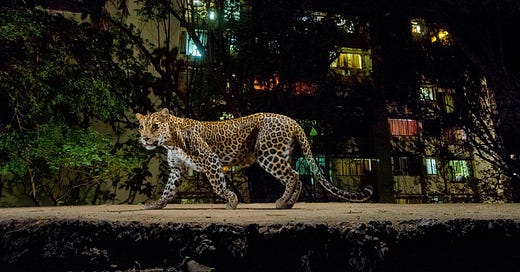WHEN LEOPARDS ROAM THE METROPOLIS (Part 1)
In India, people & predators learn to live side by side.
One ordinary November night, a 50-year-old woman visiting her sister’s family on the edge of Mumbai’s Sanjay Gandhi National Park went out to relieve herself before bed. As in most “informal settlements” in Mumbai and other rapidly expanding Indian cities, there was no toilet. Instead, the villagers of Maroshi Pada had rigged a tarp-covered latrine a short distance away from the houses. It was just after the rainy season, the latrine was a mess, and the dense vegetation provided cover in the dark. So the woman chose a spot a little outside the latrine.
She did not return to the house. When worried family members went out to look for her, they found a small banana plant trampled and some shrubs broken. Someone thought it was damage from goats. Then they heard noises from a line of trees a hundred yards away, and people began running and shouting toward the spot. It was too late. They found the woman where a leopard had dragged her into a tree by the neck.
Incidents like that are not exactly common in Mumbai. But the remarkable thing is that they occur at all in a city of 21 million people. A population of 45 or so free-ranging leopards lives in and around the park, which is roughly 30 times the size of New York City’s Central Park. They mostly leave people alone, targeting deer, street dogs, pigs, and other comparatively easy prey. (Security camera videos have caught leopards cornering a dog in a apartment lobby or being run off by a dog on a city street.) Astonishingly, people generally leave the leopards alone, angrily demanding their removal only after a leopard attacks or kills a person. From 2013 to this year so far, leopards have killed two people in the city, and injured 26 others. Imagine the tabloid headlines and the public outcry that would cause in New York City. But that total is down from a dozen deaths in the previous five years.
Working on a story about leopards for National Geographic, I spent several days visiting with victims, or their families, around Mumbai. I was curious to know how they dealt with their loss, and with the continuing danger. I wondered what that might tell us at a time when predators and people are increasingly living side by side in urbanized areas everywhere.
Maroshi Pada was my first stop. As in other informal settlements, entire families live there in one or two-room shacks, neatly maintained but made of sticks plastered with mud, sheets of rusting metal, discarded plywood, and even cardboard. Vishnu Balu Kaparde, a brother-in-law of the woman found in the tree, came out and sat on the stoop to talk. He’s a tall, lean man with a full head of curly gray hair, dark skin, and a big, relaxed grin. A granddaughter sometimes sat in front of him, and another leaned in behind. A few weeks earlier, a camera trap just down the lane had caught a leopard resting on this stoop early in the morning, five minutes before Kaparde came out for his morning pee.
I asked if a leopard ever got into anyone’s house and he pointed across the narrow alley, to the livestock room on the side of a neighbor’s house, where fifteen pigeons had gradually dwindled until the lone survivor took the hint and departed. The local dogs seemed to be ganging up in self-defense against the leopards, he said, but the last of his three cats had vanished twelve days earlier. Chickens are also standard prey.
Kaparde, who works in Mumbai’s Film City (Bollywood), often walks home through the fields in the dark. He pointed with a laugh to the low porch ceiling where he has a selection of sticks stored to carry with him, to intimidate the leopards he routinely encounters. I asked if all this made him angry with the leopards, or with the park. “This is the leopard’s house,” he said, with complete acceptance. “He is a resident of this place.” I asked a granddaughter if she was afraid of the leopards and she answered with a sharp, shy nod, then slipped away.
The fear is of course innate. The unexpected tolerance is partly the result of long experience, and partly a product of workshops on living with leopards sponsored by the park and by local conservationists. “Before, people were very aggressive about leopards. If they saw a leopard it was a big disaster. It meant the leopard was going to attack them,” said Santosh Saste, then head of the park’s emergency response team. The workshops try to get across the message that removing leopards just opens up their territory for other, less-experienced leopards. Better to stick with the ones that already know how to navigate a humanized landscape.
(to be continued tomorrow)





